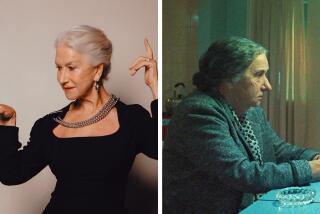The faux hawk reaches its peak
- Share via
When Brandon McWhorter’s stepfather asked why a spiked strip of hair rose from the ridge of his head, the 28-year-old’s answer was as blunt as his haircut: “She was 24, 5-8 and 108 pounds.” His stepfather nodded with approval, while his mom reacted much like other women who have seen his crop: “She thought it was cute.”
McWhorter, along with a growing clan of hipsters from Boys Town to Billyburg, are saddling into the barber’s chair and asking not for the Caesar or the cut-and-comb. Instead, they’re asking for the “faux hawk” -- a modified Mohawk, worn short (but not shaved) on the sides, with a landing strip down the center that can be slicked up or down, depending on the occasion.
The hairstyle can go from Wilshire to WeHo in minutes with only a glob of gel and a rearview mirror.
“The faux hawk is a big hit for guys who want to wear it down if they’re going to work, do business, sit in a cubicle -- that kind of thing,” says Massimo DiCicco, a hairstylist at Bumble and Bumble in Manhattan. “Or they can push it up before they go out and let their hair down.” Or up, as the case may be.
A London export brought stateside about three years ago by U.K. heartthrob David Beckham, the faux hawk was soon capping the celebrity domes of Jude Law, P. Diddy, Andy Roddick, Elijah Wood and at least half the cast of Bravo’s “Manhunt.” (Female rockers like Kelly Osbourne and Pink have also sported the look.) It wasn’t long before the style moved to the heads of young folks straddling the fence between corporate shill and stylish punk.
“The faux hawk speaks from the core of today’s metrosexual male,” says BoJesse Christopher, a 34-year-old L.A. club promoter who has been sporting the hairstyle for about a year. “But it also gets folks feeling like maybe they too should break free and rock their individuality a little.”
Unlike its uncle the Mohawk, there’s no risk of landing on the no-fly list for being a radical or reeking of egg wash or Elmer’s glue when sporting the style. Think of it as peaceful, fashionable activism.
“There is an infinite amount of rebellion in me, and my hair has always been an outlet for my need to rebel,” says McWhorter, a video engineer for the Walt Disney Co. And with a politically correct nation wary of running afoul of its government (think Dixie Chicks, Whoopi Goldberg and Cat Stevens) for some, the safest way to combat political ennui is to shake things up with their hair.
“We’re bored and restless,” says Kathie Rothkop, a “hair historian” who has been styling tresses for the hip, rich and famous in Novato, Calif., for 30 years. “When we’re bored, we begin to play with our hair as a way to express ourselves and how we feel about society.”
Adds Leonard Green, an Irvine-based, fashion show designer and devout faux-hawk wearer: “When there’s a conservative president in office, the skirts -- and the hairstyles -- start to go up.”
But few love to eat their own more than the cannibalistic fashionistas, and what was once in can suddenly be out with the turn of a (perfectly coiffed) head. When Garnier Fructis’ hair putty came with instructions on how to create the faux hawk (“blow dry on cool to set this funky ‘do”), the hairstyle was downgraded from super models to SuperCuts.
“The hipsters usually dis their old trends once the masses catch on to it,” says Adonis Samora, a 24-year-old faux-hawk wearer, part-time DJ and club promoter from West Los Angeles. “So I guess it’s not really cool for hipsters to rock a faux hawk anymore.”
A nice, pointy accent
For some, however, it’s not about politics or being hip. It’s just cute.
“I have embraced political agnosticism, especially in regards to my hair,” jokes Chris Gabrys, a 31-year-old chemist from Brooklyn who started sporting his faux hawk after seeing one on Ewan McGregor a few years ago. “I just think a pointy peak is a nice accent to the shape of my face.” Besides, he said, “I have a widow’s peak, and parting to either side makes it look like a thirtysomething comb-over.”
Of course, not everyone is a fan of the modified Mohawk -- especially the more “legit” punk rockers sporting the real deal, Mr. T style. The backlash is most recently evident in the song “Treason,” released this year by O.C. party punks, Guttermouth: “The bands all get rich / while they tell you to / the key to success is a faux hawk and mascara / it’s been done.” In short, punk rockers say, go big or go home.
*
(BEGIN TEXT OF INFOBOX)
Decades of coifs that, luckily, never took hold
Talk about bad hair days. Since the ‘50s, men have been making questionable choices when it comes to styling their tresses. From the ducktail to the Flock of Seagulls to the infamous mullet, history has shown that men sometimes don’t have the best fashion sense when it comes to their hair. No need to hang your head in shame if you’ve sported any of these ‘dos. Hindsight is, after all, 20/20.
The Ducktail: Poodle skirts aside, few symbols of the ‘50s have endured as well as the ducktail, achieved by combing the hair back to the middle of the head and making a center part with the end of a rattail comb. And because men didn’t use hairspray to style their hair back then, they opted for hair grease, giving life to the term “greasers.”
The Mop Top: When the Beatles appeared on “The Ed Sullivan Show” in 1964, long hair became fashionable for the first time since the 18th century. Havoc ensued.
The Long-hairs, with wings: The social revolution of the 1960s took root in the ‘70s, and hair became the most powerful political statement. For most of the decade, men and women of all ethnicities wore their hair long and natural. Farrah Fawcett’s “wingback” style, parted down the center and feathered back, was quickly adopted by teen idols such as Leif Garrett and the Bee Gees.
The Flock of Seagulls: A catchall term for any kind of forward-sloping, heavily sculpted ‘do, as seen on the heads of the ‘80s group A Flock of Seagulls. Interestingly (but not surprisingly) for a group founded by hairdressers, they became more famous for their hair than their music.
The Mullet: It was the “business on top, party in the back” philosophy that made the mullet popular in the ‘80s. Billy Ray Cyrus took the look to new heights, and so the hairstyle is also known as “The Billy Ray Cyrus.” That’s good news for Bono, Paul McCartney and several others who sported the ‘do during the “Decade of Excess.”
The Never-Been-Washed: The ‘90s were all about grunge, and hair was left long, scraggly and oily. Thankfully, the Caesar (see next entry) would come along and clean things up.
The Caesar: A kind of reimagined comb-over, the Caesar of the ‘90s was designed for the guy with thinning hair who could comb it all forward into wispy bangs. Hail, Caesar!
More to Read
The biggest entertainment stories
Get our big stories about Hollywood, film, television, music, arts, culture and more right in your inbox as soon as they publish.
You may occasionally receive promotional content from the Los Angeles Times.










